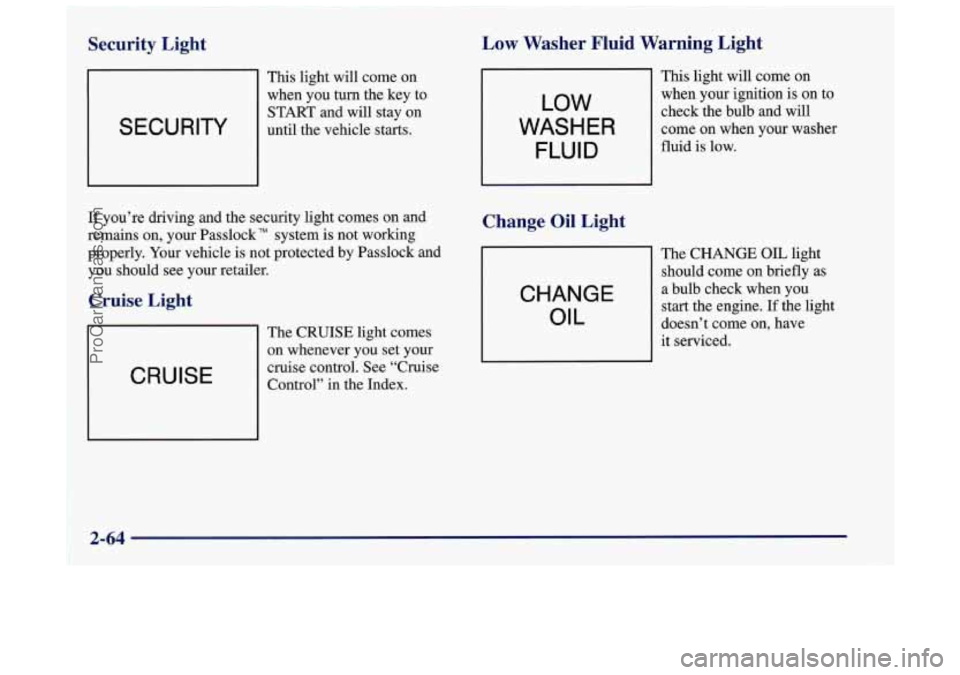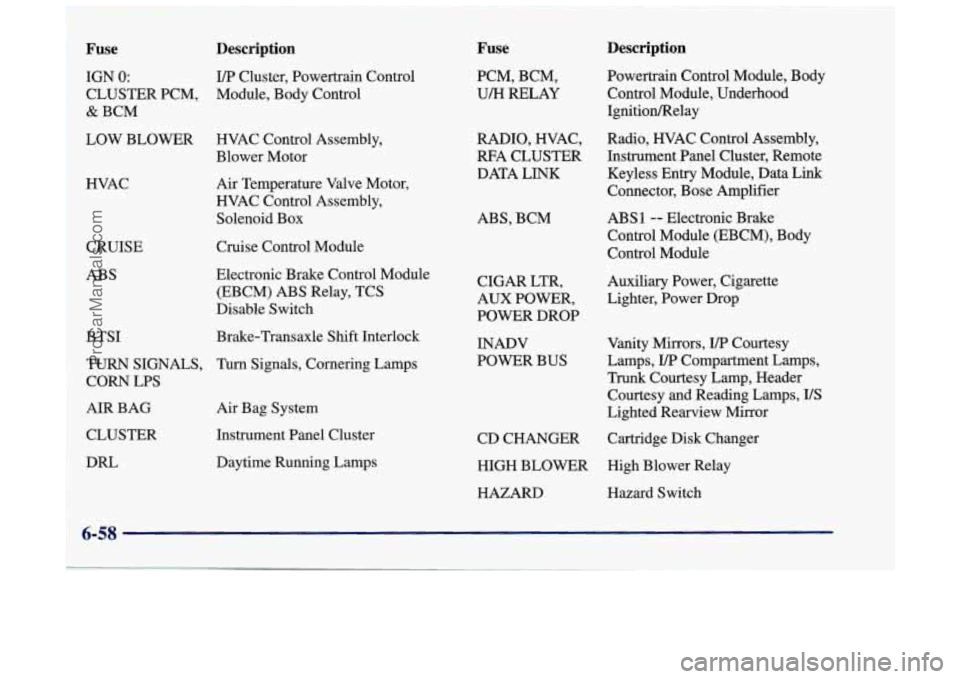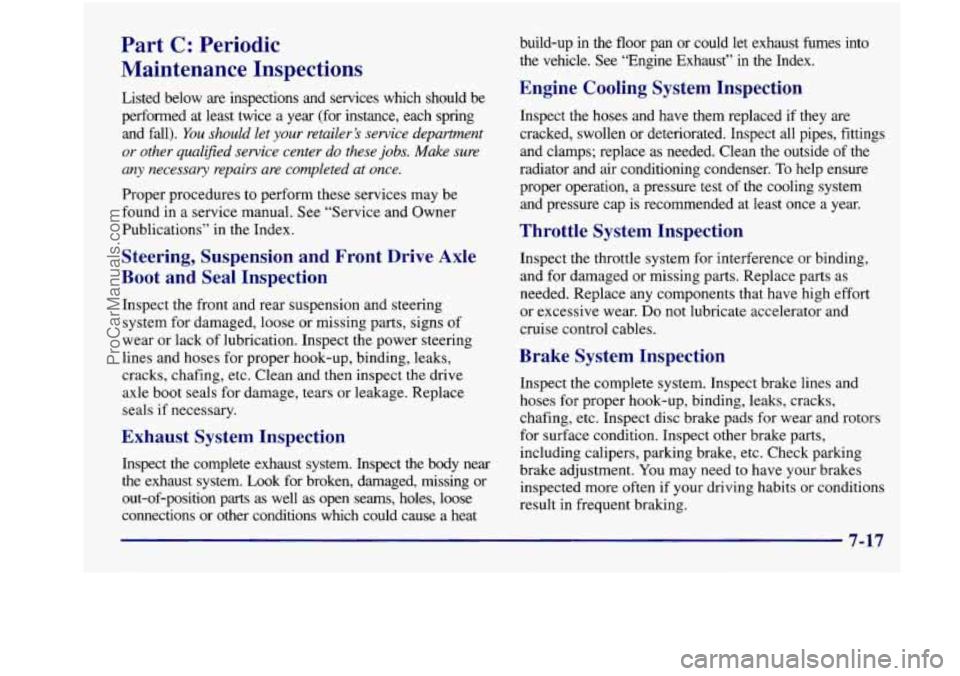cruise control OLDSMOBILE INTRIGUE 1998 Owners Manual
[x] Cancel search | Manufacturer: OLDSMOBILE, Model Year: 1998, Model line: INTRIGUE, Model: OLDSMOBILE INTRIGUE 1998Pages: 340, PDF Size: 17.93 MB
Page 95 of 340

Cruise Control
With cruise control, you can maintain a speed of about
25 mph (40 km/h) or more without keeping your foot on
the accelerator. This can really help on long trips. Cruise
control does not work at speeds below about
25 mph
(40 km/h).
When you apply your brakes, the cruise control
shuts
off.
A CAU‘ [ON:
I
Setting Cruise Control
Cruise control can be dangerous where you
can’t drive safely
at a steady speed. So,
don’t use your cruise control on winding
roads or in heavy traffic.
slippery roads. On such roads, fast changes
in tire traction can cause needless wheel
spinning, and you could lose control. Don’t
use cruise control on slippery roads.
Cruise control can be dangerous on
If you leave your cruise control switch on when
you’re not using cruise, you might hit
a button
and go into cruise when you don’t want to. You
could be startled and even lose control. Keep the
cruise control switch off until you want to use it.
I I
1. Push the cruise control
button on the instrument
panel to turn it on.
2. Get up to the speed you want.
2-35
ProCarManuals.com
Page 96 of 340

3. Push the COAST/SET
button on your steering wheel and release it. Once
you’re going about
25 rnph (40 km/h)or more,
press the RES/ACCEL
button on your steering
wheel. You’ll go right back
up to your chosen speed and
stay there.
4. Take your foot off the accelerator.
The CRUISE light on the instrument panel cluster will
come on after the cruise control has been set to the
desired speed.
It will go off when you:
step lightly on the brake pedal,
0 press CLEAR on the steering wheel or
0 press the CRUISE button on the instrument panel.
Resuming a Set Speed
Suppose you set your cruise control at a desired speed
and then you apply the brake. This, of course shuts off
the cruise control. But you don’t need to reset
it.
Increasing Speed While Using Cruise Control
There are two ways to go to a higher speed:
0
0
Use the accelerator pedal to get to the higher speed.
Press the COAST/SET button on the steering wheel,
then release the button and the accelerator pedal.
You’ll now cruise at the higher speed.
Press the RES/ACCEL button on the steering wheel.
Hold it there until you get up to the speed you want
and then release the switch. (To increase your speed
in very small amounts, press the RES/ACCEL
button for less than half a second and then release it.
Each time you do this, your vehicle will
go 1 mph
(1.6 km/h) faster.)
2-36
ProCarManuals.com
Page 97 of 340

The accelerate feature will only work after you set the
cruise control speed by pressing the COAST/SET button
on the steering wheel.
Reducing Speed While Using Cruise Control
There are two ways to reduce your speed while using
cruise control:
Press the COAST/SET button on the steering wheel
until
you reach the lower speed you want, then
release it.
To slow down in very small amounts, press the
COASTBET button on the steering wheel for less
than a half second. Each time you do this, you’ll go
1 mph (1.6 km/h) slower.
Passing Another Vehicle While Using Cruise Control
Use the accelerator pedal to increase your speed. When
you take your foot
off the pedal, your vehicle will slow
down to the cruise speed you set earlier.
Using Cruise Control on Hills
How well your cruise control will work on hills depends
upon your speed, load and the steepness of the hills.
When going up steep hills, you may have to step on the
accelerator pedal to maintain your speed. When going
downhill, you may have to brake or shift to a lower gear
to keep your speed down. Of course, applying the brake
takes you out
of cruise control. Many drivers find this to
be too much trouble and don’t use cruise control on
steep hills.
Ending Cruise Control
There are three ways to cancel the cruise control:
0 Step lightly on the brake pedal,
0 Press CLEAR on the steering wheel or
Press the CRUISE button on the instrument panel.
Erasing Cruise Speed Memory
When you turn off the cruise control or the ignition,
your cruise control set speed memory is erased.
ProCarManuals.com
Page 111 of 340

Your instrument panel is designed to let you know at a glance how your vehicle is running. You’ll know how fast
you’re going, about how much fuel is in your tank and many other things you need to drive safely and economically.
The main components of your instrument panel are:
A. Side Window Defogger Vent
B. Instrument Panel Outlets
C. Instrument Panel Cluster
D. Cruise Control
ON/OFF Switch
E. Glove Box
E Comfort Controls
G. Audio System
H. Trunk Lid Release
I. Fuel Door Release
J. Hazard Switch
K. Accessory Power Outlet
L. Trip Odometer
M. Storage Bin
N. Fog Lamp
0. Panel Dimmer
P. Ignition Switch
2-51
ProCarManuals.com
Page 124 of 340

Low Washer Fluid Warning Light
Security Light
SECURITY
This light will come on
when you turn the key to
START and will stay on
until the vehicle starts.
LOW
WASHER
FLUID
If you’re driving and the security light comes on and
remains on, your Passlock” system is not working
properly. Your vehicle is not protected by Passlock and
you should see your retailer.
Cruise Light
CRUISE
The CRUISE light comes
on whenever you set your
cruise control. See “Cruise
Control” in the Index.
This light will come on
when your ignition is on to
check
the bulb and will
come on when your washer
fluid
is low.
Change Oil Light
CHANGE
OIL
The CHANGE OIL light
should come on briefly as
a bulb check when you
start the engine.
If the light
doesn’t come
on, have
it serviced.
2-64
ProCarManuals.com
Page 286 of 340

I Fuse Description
Fuse
IGN 0: I/P Cluster, Powertrain Control
1 CLUSTER PCM, Module, Body Control
I &BCM I
1 LOW BLOWER HVAC
Control Assembly,
Blower Motor
~ HVAC
CRUISE
ABS
BTSI Air Temperature
Valve Motor,
HVAC Control Assembly,
Solenoid Box
Cruise Control Module
Electronic Brake Control Module (EBCM) ABS Relay, TCS
Disable Switch
Brake-Transaxle Shift Interlock
TURN SIGNALS, Turn Signals, Cornering Lamps CORN LPS
AIR BAG
CLUSTER
DRL Air
Bag System
Instrument Panel Cluster
Daytime Running Lamps PCM, BCM,
U/H RELAY
RADIO, WAC,
RFA CLUSTER
DATA LINK
ABS, BCM
CIGAR LTR,
AUX POWER,
POWER DROP INADV
POWER BUS
Description
Powertrain Control Module, Body
Control Module, Underhood
IgnitiodRelay
Radio, HVAC Control Assembly,
Instrument Panel Cluster, Remote
Keyless Entry Module, Data
Link
Connector, Bose Amplifier
ABS1 -- Electronic Brake
Control Module (EBCM), Body
Control Module
Auxiliary Power, Cigarette
Lighter, Power Drop
Vanity Mirrors,
I/P Courtesy
Lamps,
I/P Compartment Lamps,
Trunk Courtesy Lamp, Header Courtesy and Reading Lamps,
US
Lighted Rearview Mirror
CD CHANGER Cartridge Disk Changer
HIGH BLOWER High Blower Relay
HAZARD Hazard Switch
i 6-58
ProCarManuals.com
Page 287 of 340

Fuse
STOP LAMPS
Description
Stoplamps Switch
DOOR LOCKS Door Lock Relays (Internal to
Body Control Module) and
External Driver Door Lock Relay
POWER
MIRRORS
RED STRG
WHL ILLUM
FRT PRK LPS,
FOG LAMPS
TAIL LAMPS,
LIC LAMPS Left-hand
and Right-hand
Power Mirrors
Steering Wheel Radio Switch
Illumination
PARK LPS
-- Front Parking
Lamps, Sidemarker Lamps,
Fog lamps
Taillamps, License Lamps, Rear
Sidemarker Lamps, Rear
Sidemarker Lamps
Fuse
PANEL
DIMMING
WIPER
POWER DROP
RADIO, CRUISE
Circuit Breaker
PWR mows,
PWR SUNROOF
REAR DEFOG
POWER SEATS
Description
Dimmable Instrument
Panel Lamps
Wiper Switch
Power Drop
Radio, Steering Wheel Radio
Controls, Cruise Control Switches
Description
Power Windows, Power Sunroof
Rear Defog
Power Seats, Fuel Door Relay
6-59
ProCarManuals.com
Page 309 of 340

Part C: Periodic
Maintenance Inspections
Listed below are inspections and services which should be
performed at least twice a year (for instance, each spring
and fall).
You should let your retailer’s service department
or other qualiJied service center do these jobs. Make sure
any necessary repairs are completed at once.
Proper procedures to perform these services may be
found in a service manual. See “Service and Owner
Publications” in the Index.
Steering, Suspension and Front Drive Axle
Boot and Seal Inspection
Inspect the front and rear suspension and steering
system for damaged, loose or missing parts, signs of
wear or lack of lubrication. Inspect the power steering
lines and hoses for proper hook-up, binding, leaks,
cracks, chafing, etc. Clean and then
axle boot seals for damage, tears or
seals if necessary.
Exhaust System Inspection
Inspect the complete exhaust system. inspect
the drive
leakage. Replace
Inspect the body near
the exhaust system. Look for broken, damaged, missing
or
out-of-position parts as well as open seams, holes, loose
connections or other conditions which could cause a heat build-up in
the floor
pan or could let exhaust fumes into
the vehicle. See “Engine Exhaust” in the Index.
Engine Cooling System Inspection
Inspect the hoses and have them replaced if they are
cracked, swollen or deteriorated. Inspect all pipes, fittings
and clamps; replace as needed. Clean the outside
of the
radiator and air conditioning condenser.
To help ensure
proper operation, a pressure
test of the cooling system
and pressure cap
is recommended at least once a year.
Throttle System Inspection
Inspect the throttle system for interference or binding,
and for damaged or missing parts. Replace parts as
needed. Replace any components that have high effort
or excessive wear. Do not lubricate accelerator and
cruise control cables.
Brake System Inspection
Inspect the complete system. Inspect brake lines and
hoses for proper hook-up, binding, leaks, cracks,
chafing, etc. Inspect disc brake pads for wear and rotors
for surface condition. Inspect other brake parts,
including calipers, parking brake, etc. Check parking
brake adjustment. You may need to have your brakes
inspected more often if your driving habits
or conditions
result in frequent braking.
7-17
ProCarManuals.com
Page 329 of 340

Clock. Setting the ................................ 3-9
Comfort Controls
................................ 3-2
Compact Disc Player
............................ 3-14
Compact Spare Tire
............................. 5-35
Compass Calibration
............................ 2-45
Compass Variance
.............................. 2-44
Control of a Vehicle
.............................. 4-6
Convenience Net
............................... 2-48
Convex Outside Mirror
.......................... 2-46
Coolant
....................................... 6-21
Adding
..................................... 6-23
Checking
................................... 6-23
Heater. Engine
............................... 2-18
HOW to Add
............................ 5.19. 5.21
RecoveryTank
............................... 5-19
To Use Engine Heater ......................... 2-19
Whattouse
................................. 6-22
Cooling System
................................ 5-17
Courtesy Lamps ................................ 2-40
Courtesy Transportation
........................... 8-6
Cruise Control
................................. 2-35
Ending
...................................... 2-37
Increasing Speed While Using
................... 2-36
Light
....................................... 2-64
Passing Another Vehicle While Using
............. 2-37
ResumingaSetSpeed
......................... 2-36
Setting
..................................... 2-35
Cupholder, Center Console
....................... 2-47
Customer Assistance for Text Telephone Users
......... 8-4
Customer Assistance Information
................... 8-1
Customer Satisfaction Procedure
.................... 8-2
UsingonHills
............................... 2-37
Cupholder, Rear Console
......................... 2-47 Damage,
Finish
............................... 6-53
Damage. Sheet Metal
............................ 6-53
Daytime Running
Lamps ......................... 2-39
Defects. Reporting Safety
......................... 8-8
Defensive Driving
............................... 4-2
Defogger. Rear Window
.......................... 3-9
Defogging
..................................... 3-4
Defrosting
..................................... 3-4
Delayed Illumination
............................ 2-41
Dimen ions. Vehicle
............................ 6-63
Dolby
B Noise Reduction 3-13. 3-17
DoorLocks
..................................... 2-4
Drive. Automatic Transaxle
....................... 2-22
DriverPosition
................................. 1-11
Driving Caught
In a Blizzard .......................... 4-27
DeadBattery
................................... 5-3
8 ..................
City ........................................ 4-20
Defensive
.................................... 4-2
Drunken
..................................... 4-3
Freeway
.................................... 4-21
InaBlizzard
................................. 4-27
IntheRain
.................................. 4-17
Night
...................................... 4-16
On Curves .................................. 4-11
On Grades While Towing a Trailer
............... 4-36
On
Hill and Mountain Roads .................... 4-23
On Snow or Ice
.............................. 4-26
Throughwater
............................... 4-19
WetRoads
.................................. 4-17
In
Foreign Countries
........................... 6-5
9-3
ProCarManuals.com